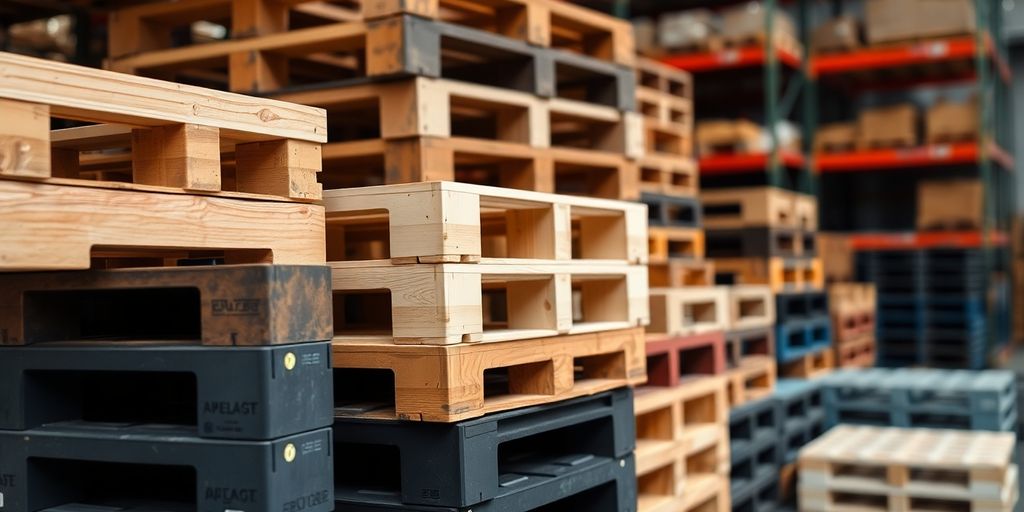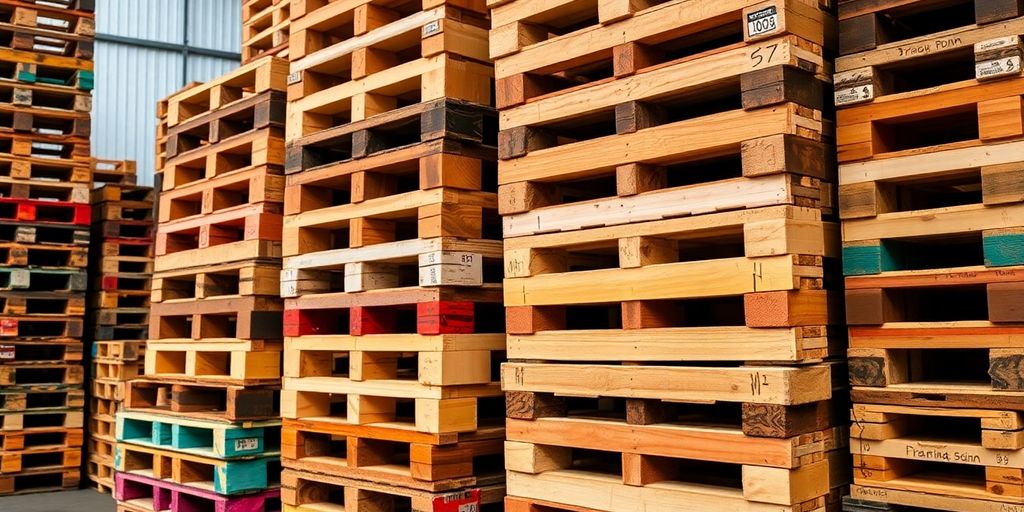Pallet distribution is a game-changer in the world of logistics. It involves the use of pallets to simplify the movement and storage of goods, making supply chains more efficient. This article explores the ins and outs of pallet distribution, highlighting its advantages, implementation strategies, and future trends. Whether you’re a small business or a large corporation, understanding pallet distribution can significantly enhance your operations.
Definition of Pallet Distribution
Pallet distribution is, at its core, about moving goods efficiently. It important individual items onto pallets for more efficient handling transportation
This method streamlines the supply chain, reducing the time and effort needed to move products from one place to another.
Consider it a method to consolidate items, making them more manageable.. is a pretty standard practise these days, and:
- you’ll find pallet distributors near me if you search online.
Importance in Supply Chain Management
Pallet distribution plays a huge role in keeping the supply chain running smoothly. is not just about convenience; it’s about making the whole process more cost-effective and reliable. By using pallets, companies can:
- Reduce handling times.
- Minimise items damage
- Improve warehouse space.
Key Components of Pallet Distribution
Effective this process involves several key components that work together. These include:
- Pallet Selection: Selecting the appropriate type pallet
- Loading Techniques:
- Transportation: Selecting the appropriate mode of transport (truck, train, ship) for pallet delivery based on:
- distance,
- cost,
- and delivery time.
- Warehouse Management: Efficiently managing pallet storage and retrieval within warehouses and distribution centres.
- Tracking and Tracing: Monitoring the movement of pallets throughout the supply chain to ensure timely delivery and prevent loss.
Advantages of Pallet Distribution
Cost Efficiency
One of the most significant advantages of palletised distribution is its ability to reduce costs across the supply chain. By fixed goods onto pallets, businesses can maximise the use of space in vehicles and warehouses.
This leads to fewer shipments, reduced fuel consumption, and lower labour expenses. Using pallets services can also help optimise these processes. Is not just about the immediate savings; it’s about creating a more streamlined and cost effective operation overall.
Improved Handling and Safety
This process significantly improves the handling and safety of goods. Pallets provide a stable base for stacking and moving items, reducing the risk of damage during transit. This is particularly crucial for or delicate products.
The use of forklifts and pallet jacks makes loading and unloading quicker and easier, minimising:
- the need for manual handling and reducing the potential for workplace injuries.
Enhanced Inventory Management
Effective inventory management is vital for any successful business, and pallet distribution plays a key role in achieving this. Pallets allow for easy tracking and organisation of goods, making it simpler to locate and retrieve items when needed. Standardised pallet sizes also facilitate efficient storage in warehouses and central hubs:
- optimising space and reducing the risk of misplaced or lost inventory.
Pallet distribution offers a structured approach to managing inventory, enabling businesses to maintain accurate stock levels and respond quickly to changing customer demands. This leads to improved order fulfilment rates and increased customer satisfaction.
Implementing Effective Pallet Distribution

Choosing the Right Pallet Type
Selecting the correct pallet is the first, and arguably most important, step. will be a surprising amount of variety out there, and the wrong choice can lead to all sorts of problems. is essential to consider as wood, plastic, and even cardboard, as well as sizes.
Consider the weight and dimensions of your goods, and the handling equipment you’ll be using. A flimsy pallet under a heavy load is a recipe for disaster. Also, think about whether you need heat-treated pallets for international shipping. Is a bit of a minefield, but getting it right pays off.
Optimising Loading Techniques
The way you load your pallets is crucial. An improperly loaded pallet is unstable, occupies more space, and is more prone to damage. Here are a few things to keep in mind:
- Distribute weight evenly, important for courier services large items when delivery goods
- Use wrapping or strapping to secure the load.
- Everything should fit neatly within the pallet’s dimensions.
- Stack items in a way that maximises space.
Utilising Technology in Pallet Distribution
Technology can significantly enhance the efficiency your pallet distribution. We’re not just discuss about fancy robots (though they can help!). Simple things like barcode scanners and warehouse management systems (WMS) can streamline the process.
A WMS can help you track pallets, manage inventory, and optimise loading. Moreover, is crucial to consider data analytics.
By analysing your pallet distribution data, you can identify bottlenecks, improve efficiency, and reduce costs. Is all about using information to make smarter decisions.
Impact on Overall Supply Chain Efficiency
Effective pallet distribution has a ripple effect throughout the entire supply chain. It reduces handling times, minimises product damage, improves warehouse space, and enhances inventory management. These factors contribute to lower costs, faster delivery times, and increased customer satisfaction.
Here’s a quick look at the benefits:
- Reduced labour costs
- Improved safety
- Better inventory accuracy
Best Practises for Pallet Distribution
Regular Training for Staff
Is easy to overlook, but consistent training is vital. Staff need to be up-to-date on the latest safety procedures, handling techniques, and equipment operation. This includes everything from proper use of pallet jacks to understanding load distribution.
Regular refreshers can help prevent accidents and minimise damage to goods. Make sure everyone knows how to safely operate a tail lift, for example.
Maintaining Equipment
This process relies heavily on equipment, so keeping it in good nick is a must. A proactive maintenance schedule can prevent breakdowns and extend the lifespan of your equipment.
- Regular inspections of forklifts and pallet jacks
- Checking and replacing worn tyres
- Ensuring all safety features are functional.
Neglecting maintenance can lead to costly repairs, delays, and even accidents. A well-maintained fleet ensures smooth operations and reduces the risk of disruptions.
Monitoring and Adjusting Processes
Is important to keep an eye on your processes and be ready to make changes as needed. This could involve:
- Tracking key performance indicators (KPIs) like loading times and damage rates.
- Analysing data to identify bottlenecks
- Implementing changes to improve workflow and reduce costs.
Final Thoughts on Pallet Distribution
In conclusion, pallet distribution plays a vital role in making supply chains more efficient. By using pallets, businesses can simplify the movement of goods, reduce costs, and improve safety in the workplace.
It is clear that using these methods can improve inventory management and speed up responses to customer needs. While there might be some initial hurdles to overcome, the long-term benefits are worth it. If you’re looking to streamline your operations, consider how pallet distribution can fit into your logistics strategy.
FAQ(Frequently Asked Questions)
What is pallet distribution?
Pallet distribution is:
- a method of moving
- and storing goods using pallets, which are flat platforms that hold items securely.
Why is pallet distribution important for businesses?
Pallet distribution is crucial because it helps businesses save time and money.
What are the main benefits of using pallet distribution?
The main benefits of pallet distribution include lower costs, improved safety for workers, and better management of stock levels. It helps businesses operate more smoothly and respond quickly to customer needs.
How can a business choose the right pallet for distribution?
To choose the right pallet for distribution, a business should consider:
- the size
- and weight of the products being transported,
- the type of handling equipment they have,
- and whether they need a standard or custom pallet.
What challenges might a company face with pallet distribution?
Some challenges in pallet distribution include ensuring:
- that pallets meet industry standards,
- making the best use of storage space,
- and preventing damage to goods during transport.
What future trends are emerging in pallet distribution?
Future trends in pallet distribution include:
- a focus on eco-friendly, the use of automation and robotics to improve efficiency,
- and the application of data analytics to enhance logistics operations.




